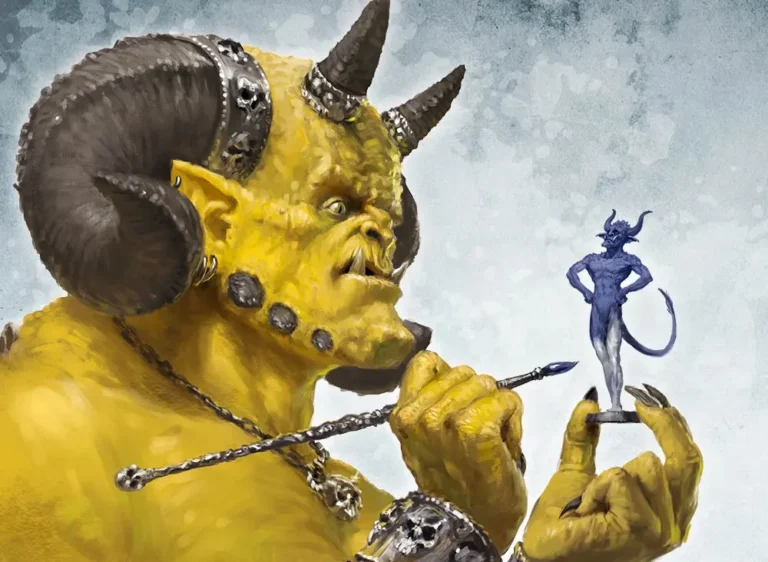This feature details everything you need to know about the competition in general and the 2025 Golden Demon edition, offering detailed insights into its history, structure, entry guidelines, categories, trophies, international editions, and even the awards ceremony.
A Brief History of Golden Demon
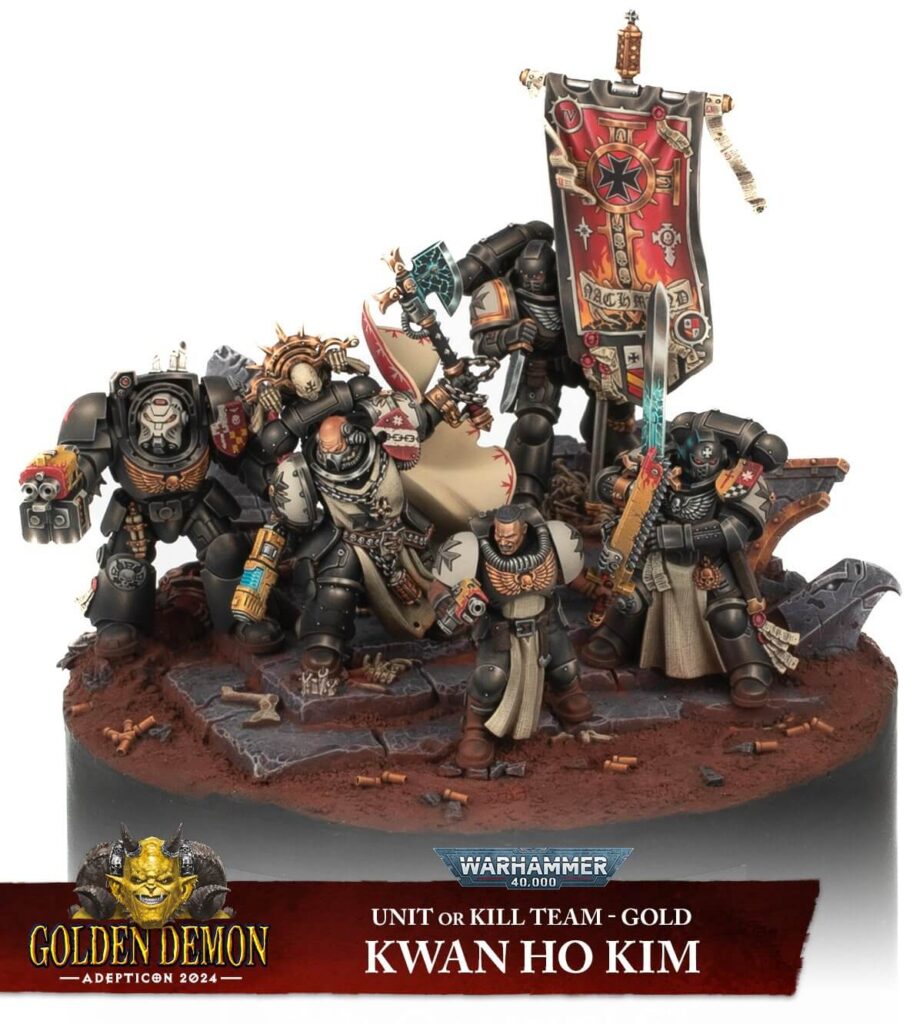
The Origins and Early Years
Golden Demon was established in 1987 in the United Kingdom by Games Workshop as a way to create a clearly defined painting competition. Prior to Golden Demon, painting contests had been held during Citadel Open Days (initiated in 1984) and at Dragonmeet conventions (dating back to 1977).
However, as competitors began entering miniatures from other companies, Games Workshop needed a competition with strict rules and clearly defined categories. The competition was devised by John Blanche (Games Workshop’s Art Director) and Andy Jones (the Convention Organiser at the time), and the first event took place on 27 June 1987 in Nottingham.
In its inaugural year, regional heats were organized across the country in Games Workshop stores and hobby shops, with the top three entries from each heat progressing to a Grand Championship Final held at Victoria Leisure Centre.
The judging was led by influential figures such as John Blanche and Bryan Ansell, and cash prizes were awarded alongside the coveted statuettes. Early categories such as “Single Character Figure,” “Single Conversion,” “Monster,” “Dragon,” “Single Mounted Figure,” “Diorama,” “Vignette,” and “Warhammer Battle Regiment” laid the foundation for many of today’s categories.
The Derby and Consolidation Years
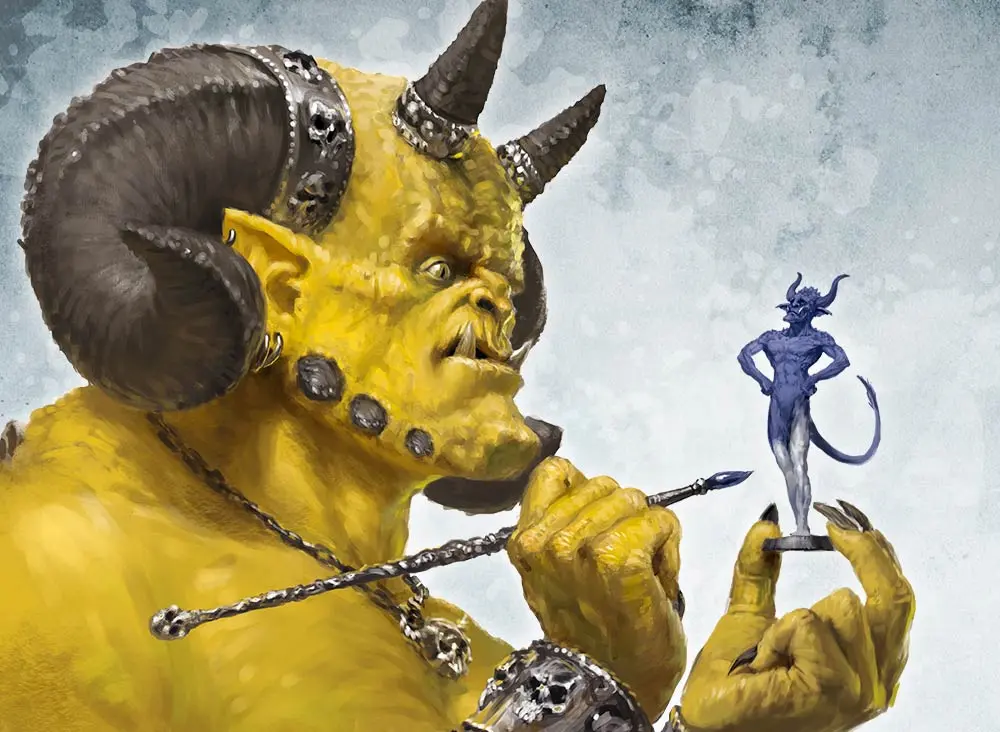
By 1989, Golden Demon had evolved from a national event into an international championship, with the Grand Final being held during Games Day in Derby.
Cash prizes continued to be awarded, and new categories—such as entries for 40K vehicles, Blood Bowl teams, and Titans—were introduced. A parallel competition known as Marauder Blade was also run, offering handcrafted short swords in categories like Orc Vignette and Single Miniature.
In 1990, Golden Demon expanded further with the introduction of a Youngbloods Competition aimed at younger painters (initially for those aged 14 or younger), and by 1991, regional heats had grown even larger. At this point, the judging panel expanded, and the competition was already garnering international recognition for spotting hidden talent. Winners from these early years often went on to have long careers in the miniature painting industry.
By the early 1990s, Golden Demon had outgrown its original venues and moved to larger spaces such as the Birmingham NEC. In 1993, the competition was held at Sheffield Arena, and for the first time, regional entries were judged in advance at the Games Workshop Studio in Nottingham to better display the miniatures on the day of the final event.
The Golden Age and Modern Era
The period from the late 1990s to the mid-2000s is fondly remembered by many as the “Golden Age” of Golden Demon. With the introduction of a modern, specific logo in 1996 and a host of category refinements, the competition saw record entries—by 1997, there were over 2,500 entries.
The judging was conducted by renowned figures like Mike McVey, Dave Andrews, and Matt Parkes. New prizes and categories were introduced, including the Forge World Best of Show and the Fanatic Morning Star, further diversifying the awards.
From 2004 onwards, the competition began to run as part of the larger Games Day event, and the introduction of the Open Competition provided an opportunity for entries that did not fit neatly into the standard categories. This period also saw major technological advances and shifts in painting techniques, which were reflected in the quality and creativity of the entries.
Many winners of this era went on to join Games Workshop’s design teams, with the competition acting as a proving ground for future studio talent.
Recent Changes and the Independent Conventions Era
In 2014, Games Workshop rebranded their flagship event from Games Day to Warhammer Fest. Golden Demon left its traditional home in Birmingham and moved to Coventry, evolving from a one-day affair to a full weekend event.
Despite a temporary decline in popularity during the early 2010s—driven by stricter rules and alternative competitions—Golden Demon has rebounded. Post-pandemic events have seen record attendance and participation, leading to further rule relaxations that allow greater creative freedom.
A pivotal moment came with the decision to end Warhammer Fest after 2023. This marked a significant shift: for the first time in nearly 50 years, Games Workshop opted not to run an in-house premier event. Instead, Golden Demon is now celebrated as part of independent gaming conventions.
In 2024, the competition returned in Germany at Spiel Essen, while the American leg is now part of Adepticon. This new era has been accompanied by changes to judging panels, category updates, and even trophy designs, ensuring that the competition continues to evolve while retaining its historic prestige.
The 2025 Competition Structure and Categories
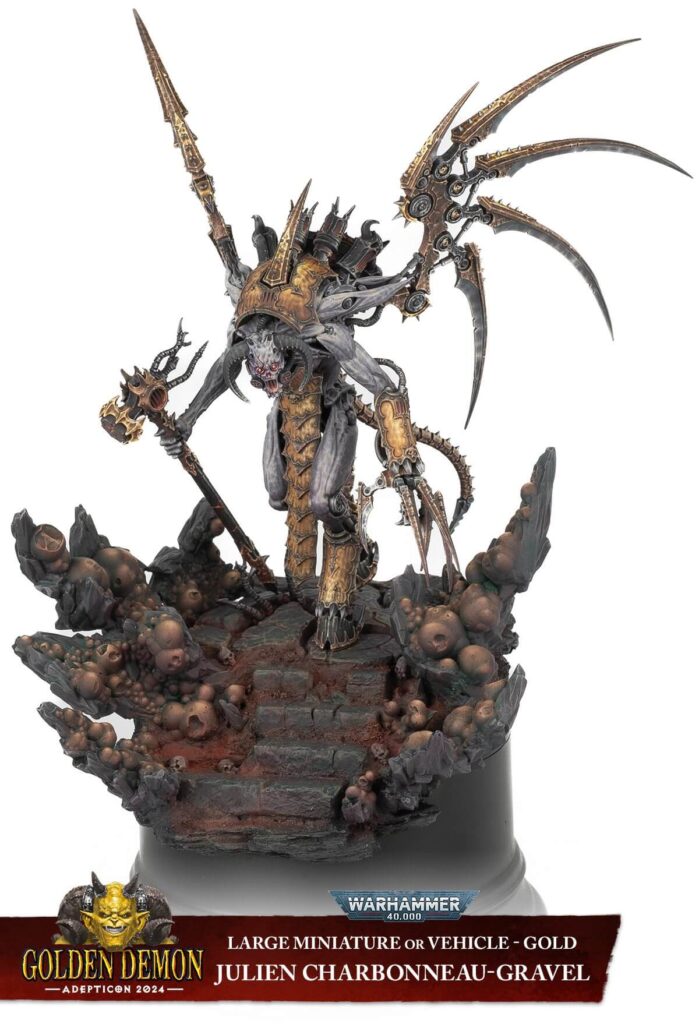
Golden Demon 2025 retains the structure that has been honed over decades. Today, the competition comprises 14 main categories, alongside two additional contests—the Youngbloods Competition and The Open Competition—which provide platforms for diverse types of entries.
Main Categories
The 14 categories cover a broad spectrum of miniature painting styles and subjects:
- Warhammer 40,000: Single Miniature
This category is dedicated to standalone miniatures from the Warhammer 40K universe. Entries may include iconic characters, infantry, or small creatures mounted on an appropriately sized base. - Warhammer 40,000: Unit or Kill Team
For groups of three or more miniatures, this category emphasizes team cohesion and narrative. Units may include infantry squads or small detachments, but must meet the minimum entry requirements. - Warhammer 40,000: Large Miniature or Vehicle
Focused on grand creations, this category is for large-scale miniatures such as tanks, walkers, or monsters. Entries should showcase both impressive scale and meticulous detail. - Warhammer Age of Sigmar: Single Miniature
Here, painters are invited to submit individual Age of Sigmar miniatures that exemplify the grandeur of this universe, from Stormcast Eternals to other iconic figures. - Warhammer Age of Sigmar: Unit, Warcry Warband or Underworlds Warband
This category celebrates group entries. It includes traditional units as well as specialized entries like Warcry or Underworlds warbands—each must consist of a minimum of three miniatures. - Warhammer Age of Sigmar: Large Miniature or War Machine
Dedicated to epic-scale models, this category is for larger miniatures and war machines. Attention to scale and detail is crucial. - Warhammer: The Horus Heresy
This category focuses on miniatures and units from the storied Horus Heresy era. Whether a single figure or a small group, entries should evoke the dramatic battles and rich lore of this period. - Warhammer: The Old World
Representing the classic Warhammer setting, this category welcomes entries that capture the dark, gritty aesthetics of the Old World. From Bretonnian knights to Tomb Kings, the category is broad and narrative-driven. - Middle-earth™ Strategy Battle Game
A category for entries inspired by Tolkien’s universe. Whether depicting duels, dioramas, or units, entries must reflect the rich narrative and historical detail of Middle-earth. - Blood Bowl
A nod to the unique mix of sport and strategy, this category is for miniatures and teams from the Blood Bowl game. The entries must be mounted correctly and capture the competitive spirit of the sport. - Necromunda
Celebrating the industrial and dystopian setting of Necromunda, this category invites entries ranging from single figures to entire gangs. The aesthetic is dark and atmospheric. - Epic Scale
For creators of grand, epic scale miniatures—whether a single titan or a small formation of large figures—this category emphasizes both monumental scale and intricate detail. - Diorama
In the diorama category, painters create scenic displays that tell a story. Whether depicting a battle scene or a quiet moment in a Warhammer universe, every element must contribute to a cohesive narrative. - Duel
Focused on head-to-head action, this category pits two opposing miniatures against one another. The narrative behind the duel, as well as the technical execution, is key.
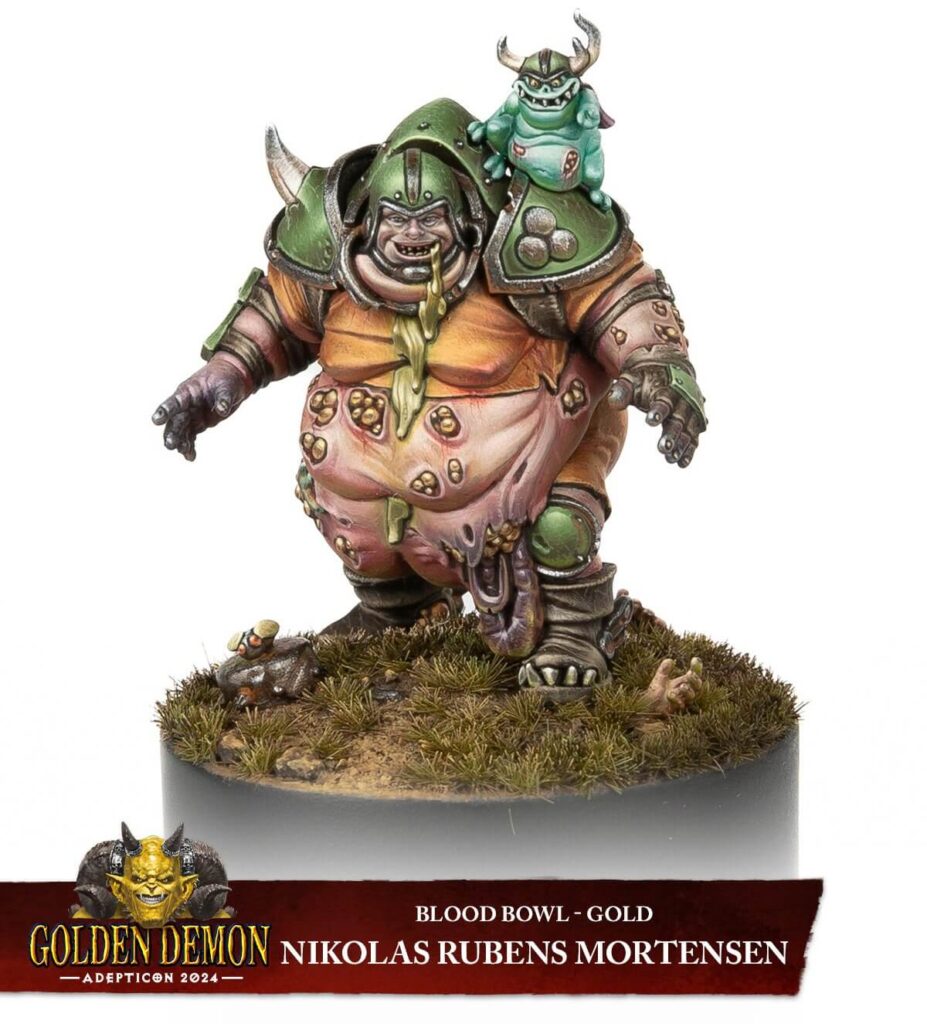
Additional Contests
- Youngbloods Competition: Tailored for young painters aged 12–15 (with the entry age now restricted to 12–15, excluding those aged 11 and under), this contest provides a platform for emerging talent. Although it runs alongside the main categories, winners in Youngbloods are not eligible for the Slayer Sword.
- The Open Competition: A flexible category for entries that do not fit into the conventional 14 categories, the Open Competition welcomes everything from busts and themed collections to small armies. It is also the only category where Games Workshop staff are permitted to compete.
How to Enter Golden Demon 2025
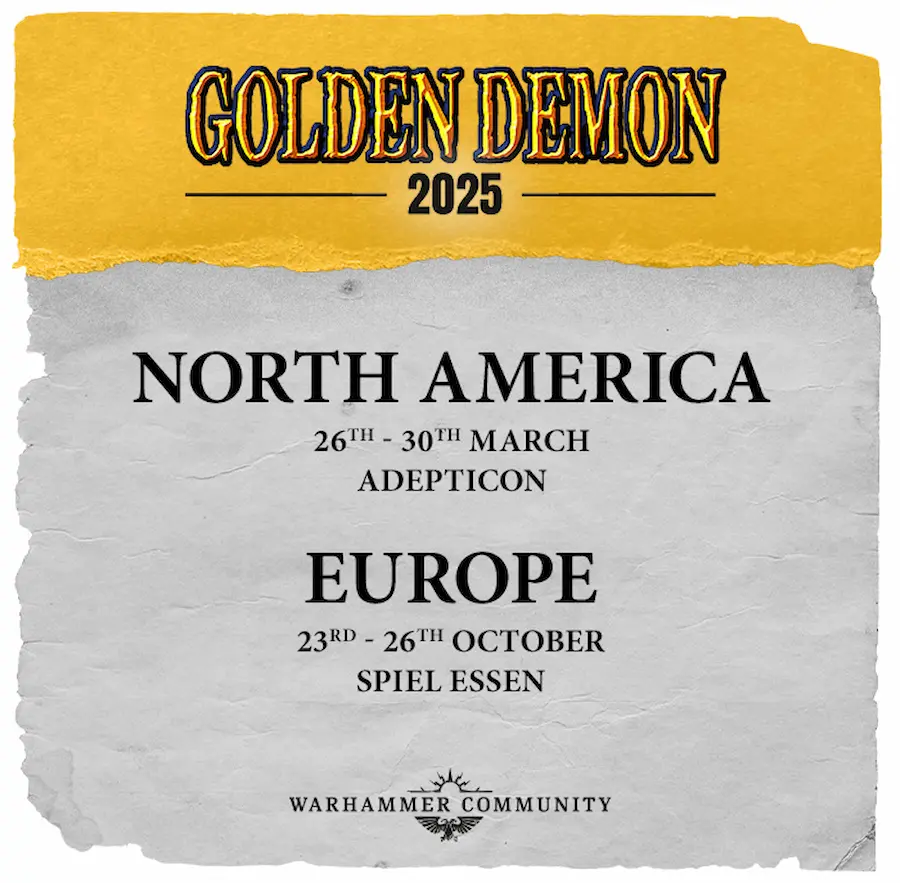
Entering Golden Demon is a process that rewards careful preparation and adherence to detailed guidelines.
Here’s a step-by-step breakdown to ensure your entry is successful:
Step 1: Purchase Your Adepticon Ticket
Before you can enter any Golden Demon category at Adepticon 2025 (including Youngbloods and The Open Competition), you must purchase your Adepticon ticket. This ticket serves as your entry pass, and proof of purchase will be required at the registration desk.
Step 2: Complete the Online Entry Form
Each participant must fill out an online entry form. Although you can complete this form at the registration desk, it is highly recommended that you do so in advance. This helps to streamline the entry process and ensures that all your details are correct.
Step 3: Be Mindful of the Deadlines
- Registration Deadline: All entries must be registered by 12:00 local time on March 29, 2025. Make sure to check the deadlines for each day of the event to avoid any last-minute issues.
- Registration Desk Hours:
- March 27: 10:00–18:00
- March 28: 10:00–18:00
- March 29: 09:00–12:00
Step 4: Submission Requirements
- In-Person Submission: Your miniature must be submitted in person by you—the artist. No third party may present your entry on your behalf. This personal touch ensures that you are present for any questions or clarifications from the judges.
- Entry Form: Each entry must be accompanied by a completed entry form that details your submission and confirms compliance with the competition rules.
Step 5: Collection and Awards
- Miniature Collection Times (March 30):
- Non-Finalist entries: From 13:00
- Finalist entries and above: From 17:00
- Awards Ceremony: The ceremony is scheduled from 16:00 to 17:00 on March 30, taking place in the Baird Ballroom. Here, all awards—including the top trophies and the prestigious Slayer Sword for the overall best-painted miniature—will be presented.
Detailed Entry Guidelines and Rules
To maintain the integrity and high standards of Golden Demon, every entry must adhere to a set of detailed guidelines. Here’s what you need to know:
Authenticity and Production
- Games Workshop Miniatures: All entries must be produced by Games Workshop. This includes Citadel Miniatures, Forge World releases, and any other products officially produced by the company—even if the miniature is out of production.
- Conversions and Scratch-Built Models: Conversions and scratch-built entries are welcome provided they adhere to the appropriate scale and remain thematically consistent with the Warhammer universes. For entries set in the Middle-earth™ universe, however, the rules are stricter, and any deviations are not allowed.
Construction and Presentation
- Mounting: Every entry must be securely mounted on an appropriate base, plinth, or display surface. Adhesives, magnets, or similar methods should be used, and loose elements are not acceptable.
- Completeness: Your miniature must be fully built, completely dry, and free from any damage. Only finished, hand-painted entries are permitted—no digitally printed or AI-assisted works are allowed.
- Hand-Painted Requirement: All miniatures must be hand-painted to reflect your personal skill and creativity. The competition does not permit digital painting techniques or any form of paint printing.
- Sculpting: If your entry involves any sculpting, it must be done from scratch. The use of 3D scanning or pre-made third-party components that replicate Games Workshop designs is strictly prohibited.
Submission Specifics
- Personal Delivery: Ensure that you are present to deliver your entry. If your miniature is damaged during transport, immediately inform the registration team to arrange for necessary repairs before the submission deadline.
- One Entry Per Category: You may enter multiple categories, but you are only allowed one entry per category. This rule helps keep the competition fair and ensures that each entry receives the attention it deserves.
- Accompanying Documentation: Each entry must include a filled-out entry form that details the miniature’s category, your chosen title, and any additional narrative or technical notes that may aid the judges.
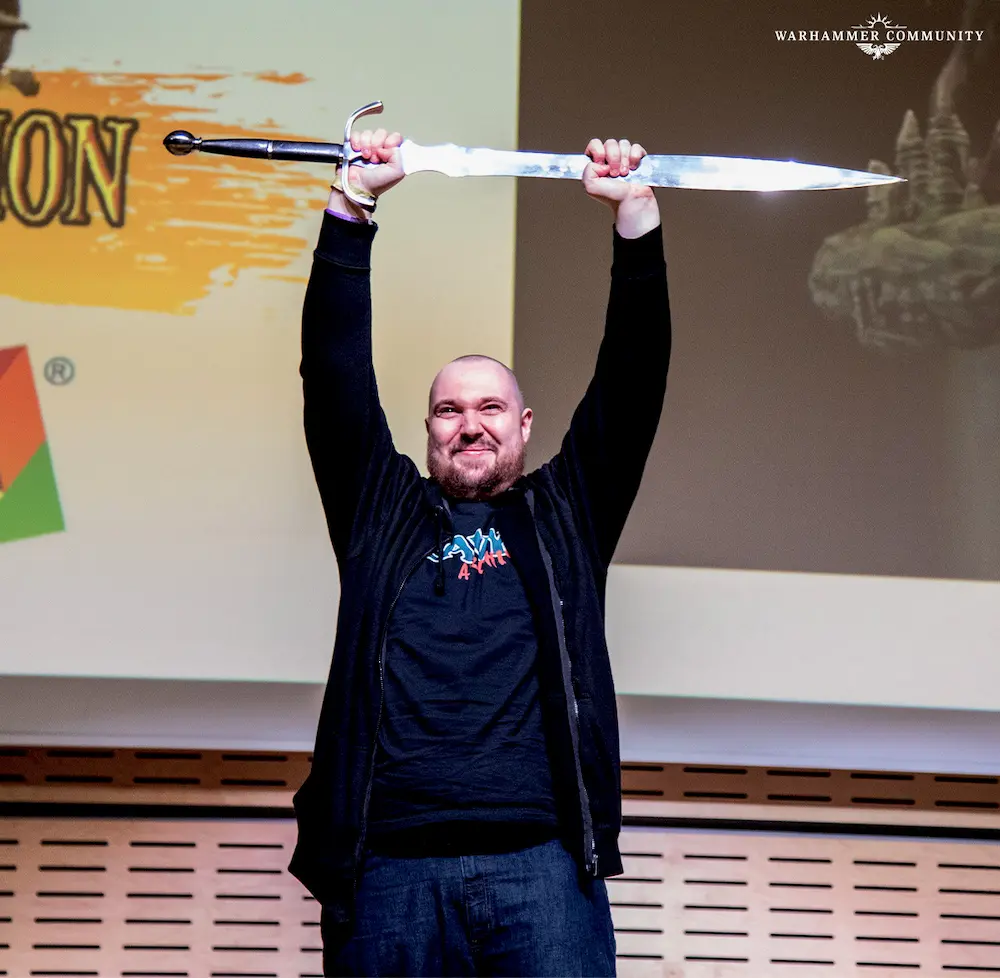
The Judging Process: What the Judges Look For
Golden Demon is renowned not only for its artistic excellence but also for the rigorous judging process. Judges evaluate every entry on several key criteria:
Technical Skill and Execution
- Painting Quality:
Judges are looking for clean lines, smooth gradients, and overall precision. The quality of your painting—how well you blend colors and highlight details—is critical to your entry’s success. - Detailing:
Consistency in detail across the miniature, including fine elements such as weathering, texture, and accent highlights, will be heavily scrutinized. Judges appreciate an entry that is polished in every aspect.
Atmosphere and Narrative
- Thematic Consistency:
Each entry should embody the spirit of its respective universe. Whether your miniature is from Warhammer 40K, Age of Sigmar, or Middle-earth™, it must tell a story and evoke the appropriate atmosphere. - Narrative Strength:
Judges value entries that not only display technical prowess but also incorporate a strong narrative element. The use of scenic elements, thoughtful composition, and storytelling through your painting can make your miniature stand out. - Originality:
While there are established styles in the Warhammer hobby, judges also look for innovative techniques and unique artistic interpretations. Your personal style should shine through without compromising the overall aesthetic of the universe you represent.
Awards Structure and Levels
Golden Demon uses a multi-tiered system of awards that recognize achievements at various levels:
- Notable Entry:
All entries that pass the first cut receive a Notable Entry pin. This initial recognition is awarded to everyone whose work meets the minimum standard. - Commended Entry:
A second cut is then applied, with select entries earning Commended Entry pins. This stage further refines the pool of submissions. - Finalist Entry:
The third cut designates Finalist Entry pins, and it is from this group that the top three winners (Gold, Silver, and Bronze) are selected in each category. - Overall Awards:
From the pool of Gold winners in every category, judges then select one entry as the overall winner. This entry is awarded the legendary Slayer Sword, the highest accolade in the competition.
Understanding the Trophy Heritage
The trophies and awards in Golden Demon are steeped in history and have evolved significantly over the years. They are not merely symbols of victory but a tangible connection to the competition’s legacy.
Golden Demon Statues
The Golden Demon trophy is instantly recognizable—a small, impish, horned demon statue that has undergone several design iterations:
- First Version (1987-1992):
Designed by Nick Bibby, this early trophy was a small (around 5 cm tall) metal statuette electroplated in Gold, Silver, or Bronze. It was mounted on a marble or wooden base, complete with an engraved plate. - Second Version (1993-1997):
Updated by sculptor Trish Morrison, this version maintained a similar size and finish while refining the overall design. - Third Version (1998):
A significant redesign by Forge World sculptor Craig Davidson, this version saw the trophy made larger (over 20 cm) and cast in resin instead of metal. The move away from electroplating meant that the trophies were painted in their awarding colors, and a cylindrical black base was used (though this introduced issues with detachment). - Fourth and Fifth Versions (1999-2002 and 2003-2019):
These versions solved the base issue by casting the statue and base as a single piece (in the fourth iteration) and later switching to a square base (in the fifth iteration) for ease of label application. - Sixth Version (2022-Present):
The current trophy, sculpted by Seb Perbet, introduces a unique twist: the Gold trophy is distinct from the Silver and Bronze versions with longer horns to symbolize its higher accolade. Although the statue and base are separate again, efforts are made to maintain structural integrity.
Occasionally, alternative trophies have been awarded (for example, a dagger in 1993 or Citadel miniatures in the mid-1990s in the US), but the Golden Demon statue remains the most iconic prize.
The Slayer Sword
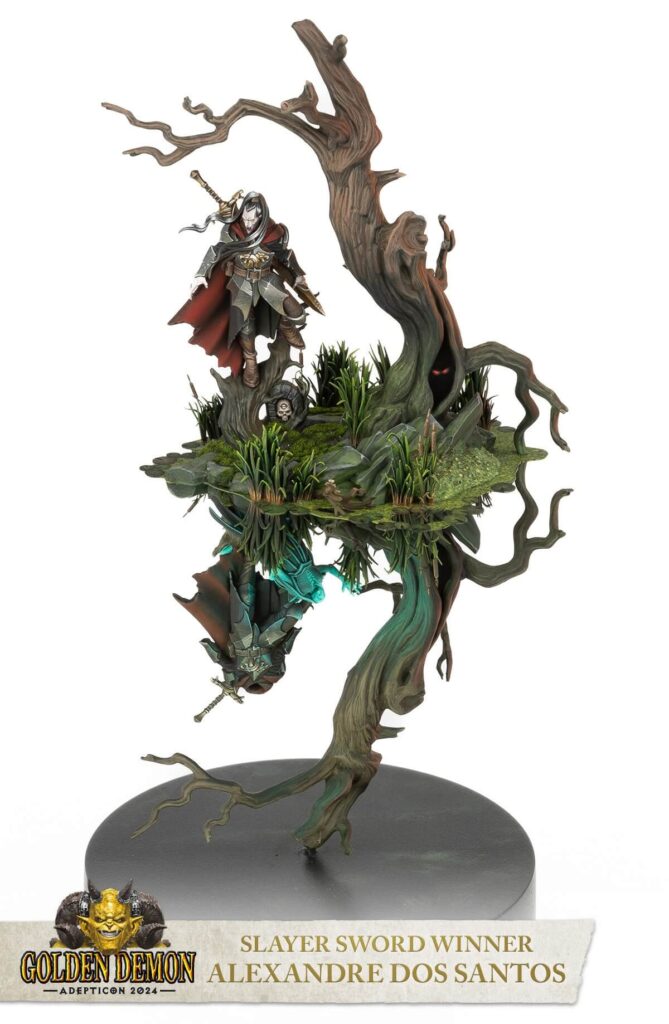
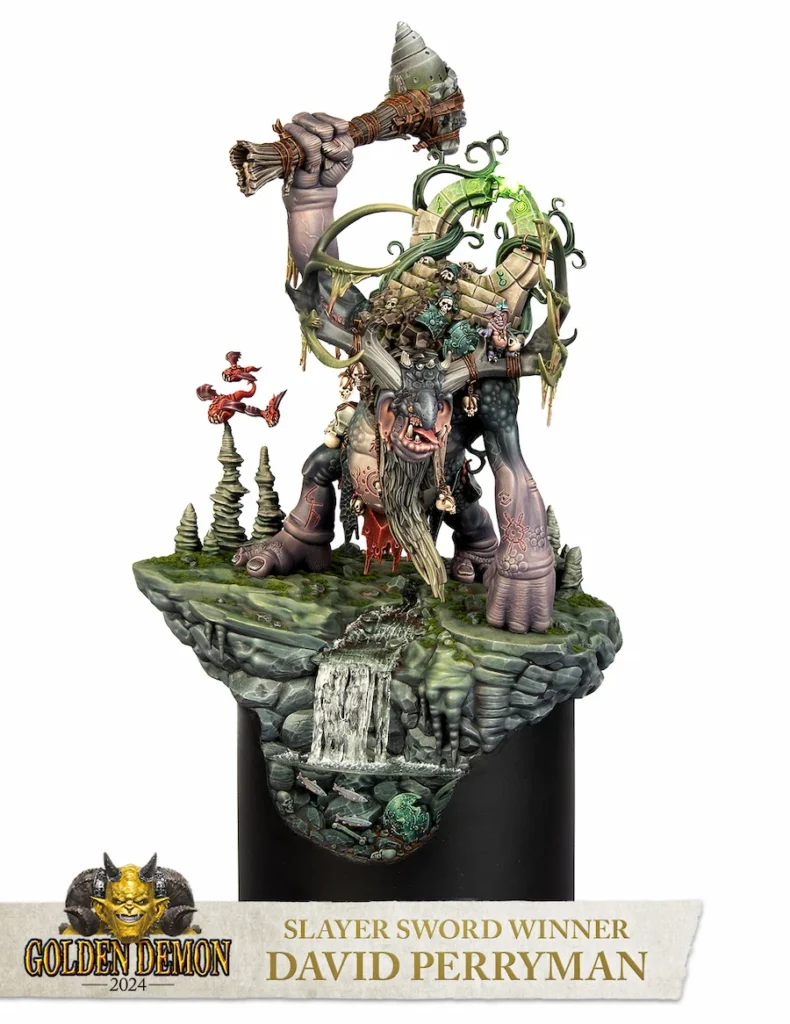
Perhaps the most coveted award in Golden Demon is the Slayer Sword. This two-handed, leafblade broadsword is awarded to the overall winner selected from the Gold-winning entries. Its history is as storied as the competition itself:
- 1987–2008: The first editions of the Slayer Sword were authentic, finely crafted blades forged by renowned British swordsmiths (including Pendragon Armourers and Raven Armoury) and measured around 125 cm in total length.
- 1996–1997: Some editions of the sword were based on historical designs, such as a Scottish Claymore, reflecting an era when traditional craftsmanship was emphasized.
- 2009–2022: In a break from tradition, Games Workshop replaced the hand-forged sword with an industrially produced, props-like sword with blunt edges. This version was sourced from China.
- 2023-Present: The current Slayer Sword remains a props-like version, but it is now manufactured by Baltimore Knife and Sword Co. in the United States. Though it is not sharpened, it retains the symbolic weight of being the ultimate accolade.
The sword’s legacy is further immortalized by its depiction in Games Workshop lore—allegedly forged by “Undead, Mind-Flaying Greater Balrog Demons” in an epic fantasy origin story.
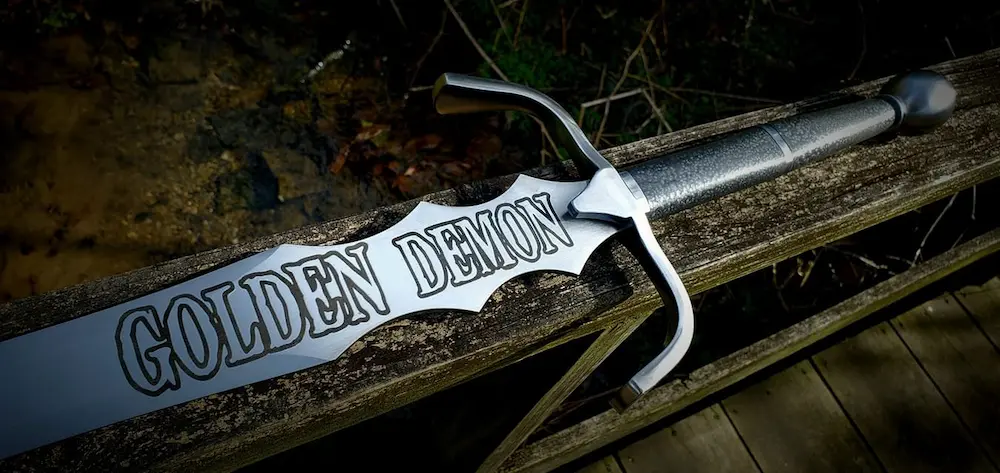
Trophies for Additional Competitions
Not all categories compete for the Slayer Sword. The Open Competition and Youngbloods Competition have their own distinctive trophies:
- Open Competition Trophy:
Winners receive a wooden plaque adorned with a relief of the Citadel castle in Gold, Silver, or Bronze finishes. - Youngbloods Trophy:
The trophy for Youngbloods features a night goblin bust, also rendered in the awarded metal finish.
Award Levels Below the Podium
Over the years, the awards structure below the main podium has evolved:
- Notable Entry Pins: Awarded to everyone who makes the first cut.
- Commended Entry Pins: Given to those who pass the second cut.
- Finalist Entry Pins: Awarded to the final group of entries from which the top three winners are selected.
This tiered system not only acknowledges excellence at every stage but also ensures that many artists receive recognition for their hard work.
International Golden Demon Competitions
Golden Demon is no longer confined to the United Kingdom. Today, it is celebrated in multiple countries, reflecting its global appeal. Here’s a look at how the competition has evolved internationally:
United States and Canada
- Origins and Evolution: Golden Demon competitions were established in the US and Canada as early as 1991. Initially held in locations such as Laurel (Maryland), Santa Monica (California), and Toronto (Ontario), these events later became part of larger Games Day celebrations.
- Games Day Legacy: For several years, multiple Games Days were held across the US (Baltimore, Chicago, Los Angeles, Atlanta), each featuring a Golden Demon competition. Over time, these events consolidated into fewer locations. Since 2022, the American leg of Golden Demon has been revived as part of Adepticon—most recently in Chicago and, from 2025, in Milwaukee.
- Judging and Participation: In earlier years, the judging in the US was conducted by members of the Design Studio. Today, while the competition is more integrated with independent conventions, the legacy of a competitive spirit remains strong.
Europe
- France and Spain: France hosted its first Golden Demon in 1997 in Paris, and it was celebrated in Paris and later in Saint-Denis until 2012. In Spain, Golden Demon began in 2000 in Barcelona (and later Madrid), where the format and trophy system sometimes differed slightly from the UK events, including awarding a single Gold trophy per category in the early years.
- Germany: Golden Demon was first introduced to Germany in 1999 as part of Games Day Germany in Cologne. After several years of local events, Germany saw a brief return of Golden Demon in 2018 during Warhammer Fest Europe. In 2024, Golden Demon returned to Germany as a standalone “Golden Demon Europe” event at Spiel Essen, marking a significant shift in its geographic focus within Europe.
- Italy, Poland, and Japan: Italy’s Golden Demon was held as part of Italian Games Day until 2013, while Poland hosted the competition as part of independent conventions (Polcon) in 2007 and 2008. In Japan, Golden Demon was held in 2012 and 2013 at the Games Workshop Japan Headquarters, though it remained a small, locally focused event due in part to legislative constraints.
The “Mini Demons” Phenomenon
In 2015, a series of smaller, themed competitions known as “Mini Demons” was introduced. Initially intended to be a lighter, alternative version of Golden Demon, these events suffered from very low entry numbers and controversy among fans. They eventually ceased after 2018, leaving behind a mixed legacy in the community’s memory.
The Awards Ceremony and Honours
The awards ceremony is the culminating highlight of Golden Demon 2025. It is an event where the entire community comes together to celebrate artistic excellence, and every participant’s effort is acknowledged.
The Awards Ceremony
- Setup and Format: In earlier years, winners were separated from other entries and placed in a special display cabinet. However, recent changes mean that all Finalist entries remain on display during the ceremony, with winners being announced on stage. This inclusive format celebrates the efforts of every painter who makes it past the initial cuts.
- The Stage Moment: During the ceremony, all Finalist artists are called to the stage, followed by the announcement of the top three winners (Gold, Silver, Bronze) in each category. Afterward, all Gold winners are invited back on stage for the ultimate honor—the presentation of the Slayer Sword to the overall best entry.
- Safety Measures: A memorable moment in the competition’s history occurred in 2006 when a winner injured himself with the sword. Since 2007, a chainmail glove is provided for the winner to safely lift the sword, although with the current non-sharpened version, this precaution is more ceremonial than necessary.
Honours Board
An honours board displaying all the Slayer Sword winners is maintained at Games Workshop’s Warhammer World exhibition centre in Nottingham. This board stands as a testament to the legacy of Golden Demon, with 164 classic Slayer Swords awarded to 108 distinct painters as of January 2025. It serves as a continuous source of inspiration for new competitors.
Preparing Your Entry: Tips, Tricks, and Best Practices
Success at Golden Demon is the result of meticulous preparation, creative passion, and adherence to the competition’s rules. Here are some expert tips to help you prepare your entry for 2025:
Start Early and Plan Meticulously
- Document Your Progress: Begin your project well in advance. Keep a record of your work-in-progress photos and notes. This documentation not only helps you track your development but may also be requested by judges to understand your creative process.
- Know Your Category: Carefully review the category descriptions to ensure that your miniature fits the intended criteria. If you are unsure, contact the competition organizers for clarification.
Adhere to Guidelines
- Review Entry Rules: Make sure your miniature is built, dry, and securely mounted on an appropriate base. Double-check that you are following all guidelines regarding paint, sculpting, and conversions.
- Plan Your Registration: Fill out the online entry form well before the registration deadline. Ensure all details are accurate to avoid delays on the day of the event.
Engage with the Community
- Share Your Work: Use social media platforms to share your progress. Engage with fellow painters using hashtags like #GoldenDemon and #WarhammerCommunity. Not only does this build excitement, but you may also receive valuable feedback.
- Learn from Past Competitors: Review past winners and their techniques. Many veteran painters are happy to share insights and tips, and there are numerous forums and video tutorials available online.
On the Day of the Competition
- Arrive Early: Being early allows you to complete any last-minute registration details and ensure your entry is properly submitted.
- Stay Calm and Confident: Remember that Golden Demon is not just about winning but also about celebrating your passion for the hobby. Enjoy the atmosphere, meet fellow artists, and soak in the creative energy of the event.
- Be Prepared for the Awards: If you reach the Finalist or podium level, be ready to present your work. Practice a brief explanation of your entry’s narrative and technical details in case judges or the audience ask questions during the ceremony.
The Legacy and Impact of Golden Demon
Golden Demon has not only been a showcase for exceptional miniature painting talent but has also played a significant role in shaping the careers of many artists in the Warhammer community. Over the decades, the competition has evolved, reflecting changes in painting techniques, modelling technologies, and artistic styles. Here’s why Golden Demon remains so influential:
Discovering Hidden Talent
Golden Demon has a storied history of uncovering emerging talent. Many painters who first gained recognition at the competition have gone on to work with Games Workshop or establish themselves as professional artists in the miniature painting industry. The competition’s rigorous standards and high visibility have made it a coveted accolade that can open doors to future opportunities.
A Catalyst for Innovation
Each Golden Demon event is a snapshot of the cutting-edge in miniature painting and modelling. Over the years, new techniques and innovative styles have emerged as competitors push the boundaries of what is possible. The competition not only rewards technical skill but also celebrates creativity and the ability to tell a compelling narrative through art.
Fostering Community and Collaboration
Golden Demon is as much about community as it is about competition. The event brings together artists, hobbyists, and fans from all over the world to share their passion. This collaborative atmosphere has led to the exchange of ideas, mentorship between veteran painters and newcomers, and a general upliftment of the standards across the hobby.
The Influence on Games Workshop
Historically, Golden Demon has also served as a scouting ground for Games Workshop’s design teams. In the past, winners received recruitment offers and had the opportunity to work alongside some of the best in the industry. Although changes in internal policy have shifted this dynamic, the competition’s legacy as a launchpad for talent remains an important part of its story.
Final Thoughts and What to Expect in 2025
Golden Demon 2025 stands as the latest chapter in a long and storied legacy. With a revamped structure under the Independent Conventions Era, international events in Germany and the United States, and updates to rules and categories that reflect the evolving nature of the hobby, this year promises to be one of the most exciting yet.
What to Expect
- A Global Celebration: With Golden Demon now taking place as part of both Spiel Essen in Germany and Adepticon in the United States, expect a truly international celebration of miniature painting. Each leg of the competition will have its own flavor, drawing in thousands of enthusiasts from different regions.
- Enhanced Categories and Rules: 2025 sees the reintroduction of classic categories alongside new adjustments that allow for greater creative freedom. Whether you’re competing in the core 14 categories, the Youngbloods Competition, or the Open Competition, every entry is set to be judged fairly and with an eye for both technical skill and narrative strength.
- A Memorable Awards Ceremony: The awards ceremony remains one of the highlights of Golden Demon. With all Finalist entries celebrated on stage and the momentous presentation of the Slayer Sword to the overall winner, the ceremony is designed to honor every artist’s effort and create lasting memories.
- A Platform for the Future: Golden Demon is not just about this year’s competition—it’s about building a legacy for the future. The honours board at Warhammer World, the evolving trophy designs, and the constant influx of fresh talent ensure that Golden Demon will continue to inspire painters for years to come.
As you prepare for Golden Demon 2025, remember that every brushstroke, every detail, and every moment of creative expression contributes to a legacy that spans nearly four decades. This guide is designed to equip you with all the knowledge you need—from the competition’s history and structure to the nuances of the awards and the expectations on the day of the event.
Take the time to plan your entry meticulously, engage with the community, and most importantly, enjoy the process. Whether you emerge as a finalist or simply take pride in having participated in such an esteemed competition, Golden Demon is a celebration of the passion and artistry that drive the Warhammer hobby.
Good luck, and may your work shine brilliantly among the many masterpieces at Golden Demon 2025!
Related Articles:
- All Golden Demon 2024 Winners
- Golden Demon 2024 – New Updates and Recap of Everything we know so far!
FAQs
Who holds the most classic Slayer Sword wins in different regions?
In America, Todd Swanson leads with 5 Slayer Swords. In Europe, Matt Parkes has earned 4, and in Australia, Glen Lamprecht also boasts 4 wins.
Which painter is the most decorated in Golden Demon trophy history?
Angelo Di Chello stands out as the most decorated painter, having secured 65 classic trophies across various countries.
Who is the youngest ever Slayer Sword winner?
Iago Pineda is the youngest winner; he claimed the Spanish Slayer Sword in 2004 at the age of 15, just one year after winning Youngbloods.
Who holds the record for most consecutive Gold awards in a single category?
Neil R Thomason achieved four consecutive Golds in the UK’s Single 40K Miniature category from 1993 to 1996.
Which painter has won the most Forge World Best of Show awards?
Ben Komets holds that record, having won 4 Forge World Best of Show trophies.
Among painters with multiple wins, who has the highest success rate?
Rubén Martínez is remarkably efficient—he has won Gold every time he entered and clinched the Slayer Sword in 2 out of 3 of his attempts.
Are there any competitions where the Slayer Sword has only been won by host country nationals?
Yes, in both the Australian and Spanish Golden Demon competitions, only nationals of the host country have won the Slayer Sword.
How many Slayer Swords have been awarded overall?
As of January 2025, 164 classic Slayer Swords have been awarded to 108 distinct painters.

